Effects of Post-Weld Heat Treatment on Microstructure and Mechanical Properties of the Brazed Joint of a Novel Fourth-Generation Nickel-Based Single Crystal Superalloy
Abstract
:1. Introduction
2. Experimental Procedures
3. Results and Discussion
3.1. Microstructure of Brazed Joint
3.2. Effect of PWHT on the Microstructure of Brazed Joint
3.3. Effect of PWHT on Mechanical Properties of Brazed Joint
3.3.1. Microhardness
3.3.2. Tensile and Stress Rupture Properties
4. Conclusions
- The non-isothermal solidification zone (NSZ) and the isothermal solidification zone (ISZ) were observed in the brazed joint. The NSZ was composed of M3B2, MB-type boride, MC carbide and γ matrix, and the ISZ was consisted of γ and γ’ phases with different sizes. The simulation results of the residual liquid phase in the joint are basically consistent with the experimental results.
- After the PWHT, the boride in NSZ changed into discrete block distribution and needle boride precipitated in ISZ-1. The formation and evolution of P-γ’ in ISZ-2 and S-γ’ in ISZ-1 are mainly related to the diffusion effect of boride on Al and Ta atoms. In addition, high-angle grain boundaries formed in the joint, which is related to the nucleation and growth of grains during recrystallization.
- The microhardness of the joint (except NSZ) after the PWHT is slightly higher than that before the PWHT. The boride distribution controls the microhardness of NSZ, and the microhardness of ISZ is affected by the solid solution strengthening of the γ matrix and precipitation strengthening of the γ’ phase.
- After the PWHT, the tensile strength and stress rupture life of the joint are significantly improved. MC carbides pinned at grain boundaries and the discontinuous blocky borides play a critical role in the mechanical properties of the joint. The fracture surfaces of tensile and stress rupture joints are quasi-cleavage fracture and intergranular fracture of microporous aggregation, respectively.
Author Contributions
Funding
Institutional Review Board Statement
Informed Consent Statement
Data Availability Statement
Conflicts of Interest
References
- Reynolds, T.D.; Collins, D.M.; Soor, N.K.; Street, S.R.; Warnken, N.; Mignanelli, P.M.; Hardy, M.C.; Evans, H.E.; Taylor, M.P. Identifying Heating Rate Dependent Oxidation Reactions on a Nickel-Based Superalloy Using Synchrotron Diffraction. Acta Mater. 2019, 181, 570–583. [Google Scholar] [CrossRef]
- Zhang, Q.; Chang, Y.; Gu, L.; Luo, Y.; Ge, B. Study of Microstructure of Nickel-Based Superalloys at High Temperatures. Scr. Mater. 2017, 126, 55–57. [Google Scholar] [CrossRef]
- Rae, C.M.F.; Reed, R.C. Primary Creep in Single Crystal Superalloys: Origins, Mechanisms and Effects. Acta Mater. 2007, 55, 1067–1081. [Google Scholar] [CrossRef]
- Xu, K.; Wang, G.; Liu, J.; Li, J.; Liu, J.; Wang, X.; Yang, Y.; Ye, L.; Zhou, Y.; Sun, X. Creep Behavior and a Deformation Mechanism Based Creep Rate Model under High Temperature and Low Stress Condition for Single Crystal Superalloy DD5. Mater. Sci. Eng. A 2020, 786, 139414. [Google Scholar] [CrossRef]
- Zhang, P.; Li, J.; Gong, X.F.; Yuan, Y.; Gu, Y.F.; Wang, J.C.; Yan, J.B.; Yin, H.F. Creep Behavior and Deformation Mechanisms of a Novel Directionally Solidified Ni-Base Superalloy at 900 °C. Mater. Charact. 2019, 148, 201–207. [Google Scholar] [CrossRef]
- Wu, Y.; Zhao, H.; Li, J.; Zhang, Y.; Liu, J.; Liu, T. An Innovative Approach towards Forming the Serrated Grain Boundaries and Refining the γ’ Precipitates in Nickel-Based Superalloys. J. Alloys Compd. 2022, 908, 164570. [Google Scholar] [CrossRef]
- Seo, S.M.; Lee, J.H.; Yoo, Y.S.; Jo, C.Y.; Miyahara, H.; Ogi, K. A Comparative Study of the γ/Γ’ Eutectic Evolution during the Solidification of Ni-Base Superalloys. Metall. Mater. Trans. A 2011, 42, 3150–3159. [Google Scholar] [CrossRef]
- Ratel, N.; Demé, B.; Bastie, P.; Caron, P. In Situ SANS Investigation of the Kinetics of Rafting of Γ’ Precipitates in a Fourth-Generation Single-Crystal Nickel-Based Superalloy. Scr. Mater. 2008, 59, 1167–1170. [Google Scholar] [CrossRef]
- Yeh, A.C.; Tin, S. Effects of Ru and Re Additions on the High Temperature Flow Stresses of Ni-Base Single Crystal Superalloys. Scr. Mater. 2005, 52, 519–524. [Google Scholar] [CrossRef]
- Tan, Z.H.; Wang, X.G.; Ye, L.H.; Hou, G.C.; Li, R.; Yang, Y.H.; Liu, J.L.; Liu, J.D.; Yang, L.; Wang, B.; et al. Effects of Rhenium on the Microstructure and Creep Properties of Novel Nickle-Based Single Crystal Superalloys. Mater. Sci. Eng. A 2019, 761, 138042. [Google Scholar] [CrossRef]
- Song, W.; Wang, X.G.; Li, J.G.; Meng, J.; Duan, T.F.; Yang, Y.H.; Liu, J.L.; Liu, J.D.; Pei, W.L.; Zhou, Y.Z.; et al. The Formation and Evolution of NiAl Phase in a Fourth Generation Nickel-Based Single Crystal Superalloy. J. Alloys Compd. 2020, 848, 156584. [Google Scholar] [CrossRef]
- Ahmed, S.; Biswas, A.N. René 41 & Waspaloy Based Comparative Study for High Pressure Turbine Blades Used in Turboshaft Engines. Mater. Today Proc. 2022, 56, 1234–1241. [Google Scholar] [CrossRef]
- Zhang, C.; Wang, P.; Wen, Z.; Xu, Z.; He, P.; Yue, Z. Study on Creep Properties of Nickel-Based Superalloy Blades Based on Microstructure Characteristics. J. Alloys Compd. 2022, 890, 161710. [Google Scholar] [CrossRef]
- Li, X.; Li, W.; Lashari, M.I.; Sakai, T.; Wang, P.; Cai, L.; Ding, X.; Hamid, U. Fatigue Failure Behavior and Strength Prediction of Nickel-Based Superalloy for Turbine Blade at Elevated Temperature. Eng. Fail. Anal. 2022, 136, 106191. [Google Scholar] [CrossRef]
- Zhou, X.; Huang, Y.; Chen, Y.; Li, S.; Guo, W.; Peng, P. Brazing of Ni-Based Single Crystal Superalloy with High Carbon Content γ Layer. Appl. Surf. Sci. 2020, 514, 145936. [Google Scholar] [CrossRef]
- Ruiz-Vargas, J.; Siredey-Schwaller, N.; Gey, N.; Bocher, P.; Hazotte, A. Microstructure Development during Isothermal Brazing of Ni/BNi-2 Couples. J. Mater. Process. Technol. 2013, 213, 20–29. [Google Scholar] [CrossRef]
- Neumeier, S.; Dinkel, M.; Pyczak, F.; Göken, M. Nanoindentation and XRD Investigations of Single Crystalline Ni–Ge Brazed Nickel-Base Superalloys PWA 1483 and René N5. Mater. Sci. Eng. A 2011, 528, 815–822. [Google Scholar] [CrossRef] [Green Version]
- Liu, D.; Song, Y.; Shi, B.; Zhang, Q.; Song, X.; Niu, H.; Feng, J. Vacuum Brazing of GH99 Superalloy Using Graphene Reinforced BNi-2 Composite Filler. J. Mater. Sci. Technol. 2018, 34, 1843–1850. [Google Scholar] [CrossRef]
- Wang, G.; Sun, Y.; Wang, X.; Liu, J.; Liu, J.; Li, J.; Yu, J.; Zhou, Y.; Jin, T.; Sun, X.; et al. Microstructure Evolution and Mechanical Behavior of Ni-Based Single Crystal Superalloy Joint Brazed with Mixed Powder at Elevated Temperature. J. Mater. Sci. Technol. 2017, 33, 1219–1226. [Google Scholar] [CrossRef]
- Cao, J.; Wang, Y.F.; Song, X.G.; Li, C.; Feng, J.C. Effects of Post-Weld Heat Treatment on Microstructure and Mechanical Properties of TLP Bonded Inconel718 Superalloy. Mater. Sci. Eng. A 2014, 590, 1–6. [Google Scholar] [CrossRef]
- Pouranvari, M.; Ekrami, A.; Kokabi, A.H. Microstructure Evolution Mechanism during Post-Bond Heat Treatment of Transient Liquid Phase Bonded Wrought IN718 Superalloy: An Approach to Fabricate Boride-Free Joints. J. Alloys Compd. 2017, 723, 84–91. [Google Scholar] [CrossRef]
- Pouranvari, M.; Ekrami, A.; Kokabi, A.H. Diffusion Brazing of Cast INCONEL 718 Superalloy Utilising Standard Heat Treatment Cycle. Mater. Sci. Technol. 2014, 30, 109–115. [Google Scholar] [CrossRef]
- Zhang, J.; Zhang, Z.; Sun, J.; Liu, X.; Tian, W. Effect of Heat Treatment on High Temperature Stress Rupture Strength of Brazing Seam for Nickel-Base Superalloy. J. Univ. Sci. Technol. Beijing Miner. Metall. Mater. Eng. Ed. 2001, 8, 123–125. [Google Scholar]
- Bakhtiari, R.; Ekrami, A.; Khan, T.I. Microstructure-Mechanical Properties Relation of TLP-Bonded FSX-414 Superalloy: Effect of Homogenization Design. J. Mater. Eng. Perform. 2015, 24, 1687–1696. [Google Scholar] [CrossRef]
- Arhami, F.; Mirsalehi, S.E. The Effect of Heat Treatment Sequence on Microstructure and Mechanical Properties of Diffusion Brazed IN-939 Superalloy. J. Mater. Process. Technol. 2019, 266, 351–362. [Google Scholar] [CrossRef]
- Zhang, Z.P.; Liu, J.D.; Qiu, K.Q.; Huang, Y.Y.; Li, J.G.; Wang, X.G.; Liu, J.L.; Wang, M.; Zou, M.K.; Zhou, Y.Z. Effects of Brazing Temperature on Microstructure and High-Temperature Strength of Joints Using a Novel Fourth-Generation Nickel-Based Single Crystal Superalloy. Met. Mater. Int. 2022, 1–13. [Google Scholar] [CrossRef]
- Liu, J.; Jin, T.; Zhao, N.; Wang, Z.; Sun, X.; Guan, H.; Hu, Z. Microstructural Study of Transient Liquid Phase Bonded DD98 and K465 Superalloys at High Temperature. Mater. Charact. 2011, 62, 545–553. [Google Scholar] [CrossRef]
- Pouranvari, M.; Ekrami, A.; Kokabi, A.H. Solidification and Solid State Phenomena during TLP Bonding of IN718 Superalloy Using Ni–Si–B Ternary Filler Alloy. J. Alloys Compd. 2013, 563, 143–149. [Google Scholar] [CrossRef]
- Wang, S.Y.; Hou, X.Y.; Cheng, Y.; Wang, L.; Sun, Y.; Zhang, H.W.; Yang, Y.H.; Li, J.G.; Zhou, Y.Z. Investigation on the Solidification Behavior in a Brazed Joint of the γ’-Strengthened Co-Based Single Crystal Superalloy. Mater. Charact. 2022, 186, 111793. [Google Scholar] [CrossRef]
- Yue, X.; Liu, F.; Li, Q.; Qin, H.; Gao, H.; Li, L.; Yi, Y. Effect of Post-Bond Heat Treatment on Microstructure and Mechanical Properties of the Wide Gap TLP Bonded IC10 Superalloy with a Low Boron Ni3Al-Based Interlayer. J. Manuf. Process. 2020, 54, 109–119. [Google Scholar] [CrossRef]
- Ding, Q.; Lao, Z.; Wei, H.; Li, J.; Bei, H.; Zhang, Z. Site Occupancy of Alloying Elements in Γ′ Phase of Nickel-Base Single Crystal Superalloys. Intermetallics 2020, 121, 106772. [Google Scholar] [CrossRef]
- Pound, G.M. Perspectives on Nucleation. Metall. Trans. Phys. Metall. Mater. Sci. 1985, 16, 487–502. [Google Scholar] [CrossRef]
- Wendt, H.; Haasen, P. Nucleation and Growth of Γ′-Precipitates in Ni-14 at % Al. Acta Metall. 1983, 31, 1649–1659. [Google Scholar] [CrossRef]
- Sheng, N.C.; Liu, J.D.; Jin, T.; Sun, X.F.; Hu, Z.Q. Wide Gap TLP Bonding a Single-Crystal Superalloy: Evolution of the L/S Interface Morphology and Formation of the Isolated Grain Boundaries. Metall. Mater. Trans. A 2013, 44, 1793–1804. [Google Scholar] [CrossRef]
- Li, X.; Cheng, Z.; Qu, S.; Zhu, D.; Li, H. Effect of Filler Metal on the Microstructural Evolution and Mechanical Properties of Wide Gap Brazed K417G Superalloy Joints. Vacuum 2021, 184, 109967. [Google Scholar] [CrossRef]
- Gypen, L.A.; Deruyttere, A. Multi-Component Solid Solution Hardening—Part 1 Proposed Model. J. Mater. Sci. 1977, 12, 1028–1033. [Google Scholar] [CrossRef]
- Roth, H.A.; Davis, C.L.; Thomson, R.C. Modeling Solid Solution Strengthening in Nickel Alloys. Metall. Mater. Trans. A 1997, 28, 1329–1335. [Google Scholar] [CrossRef]
- Pouranvari, M. Solid Solution Strengthening of Transient Liquid Phase Bonded Nickel Based Superalloy. Mater. Sci. Technol. 2015, 31, 1773–1780. [Google Scholar] [CrossRef]
- Pouranvari, M.; Ekrami, A.; Kokabi, A.H. Microstructure—Properties Relationship of TLP-Bonded GTD-111 Nickel-Base Superalloy. Mater. Sci. Eng. A 2008, 490, 229–234. [Google Scholar] [CrossRef]
- Wang, X.G.; Liu, J.L.; Jin, T.; Sun, X.F. The Effects of Ruthenium Additions on Tensile Deformation Mechanisms of Single Crystal Superalloys at Different Temperatures. Mater. Des. 2014, 63, 286–293. [Google Scholar] [CrossRef]
- Tan, X.P.; Liu, J.L.; Song, X.P.; Jin, T.; Sun, X.F.; Hu, Z.Q. Measurements of γ/γ’ Lattice Misfit and γ’ Volume Fraction for a Ru-Containing Nickel-Based Single Crystal Superalloy. J. Mater. Sci. Technol. 2011, 27, 899–905. [Google Scholar] [CrossRef]
- Song, W.; Wang, X.G.; Li, J.G.; Meng, J.; Yang, Y.H.; Liu, J.L.; Liu, J.D.; Zhou, Y.Z.; Sun, X.F. Effect of Ru on Tensile Behavior and Deformation Mechanism of a Nickel-Based Single Crystal Superalloy. Mater. Sci. Eng. A 2021, 802, 140430. [Google Scholar] [CrossRef]
- Wang, S.; Hou, X.; Cheng, Y.; Sun, Y.; Yang, Y.; Li, J.G.; Zhang, H.; Zhou, Y. Effect of Temperature on the Tensile Deformation Behavior and Fracture Mechanism of a Transient Liquid-Phase Bonding Joint of Γ′-Strengthened Co-Based Single-Crystal Superalloy. J. Mater. Sci. 2022, 57, 12012–12033. [Google Scholar] [CrossRef]
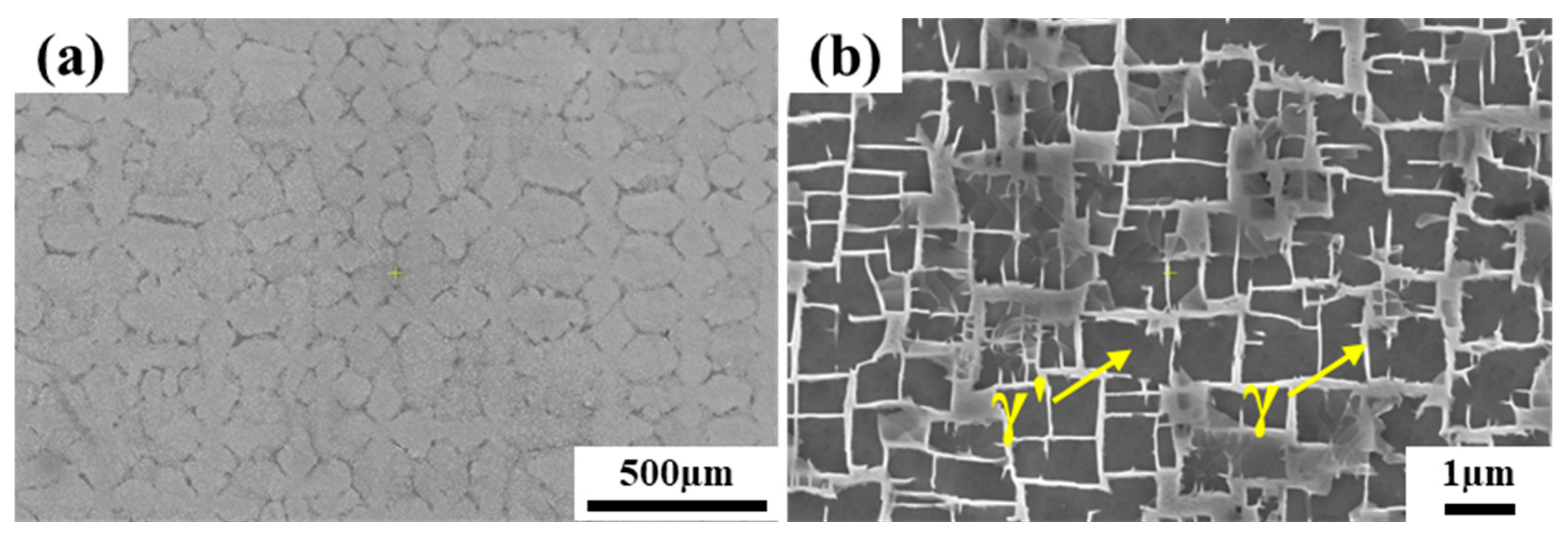


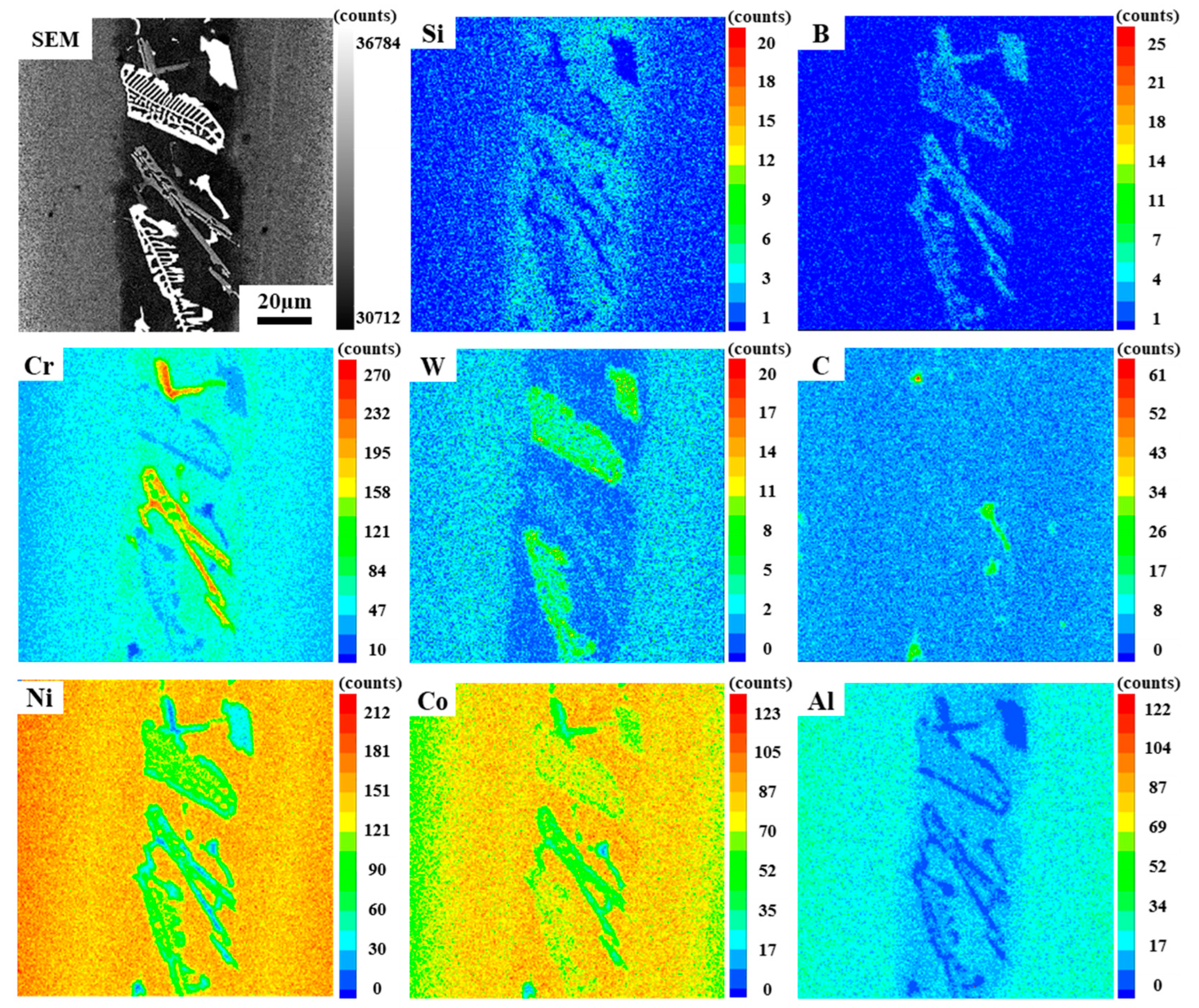
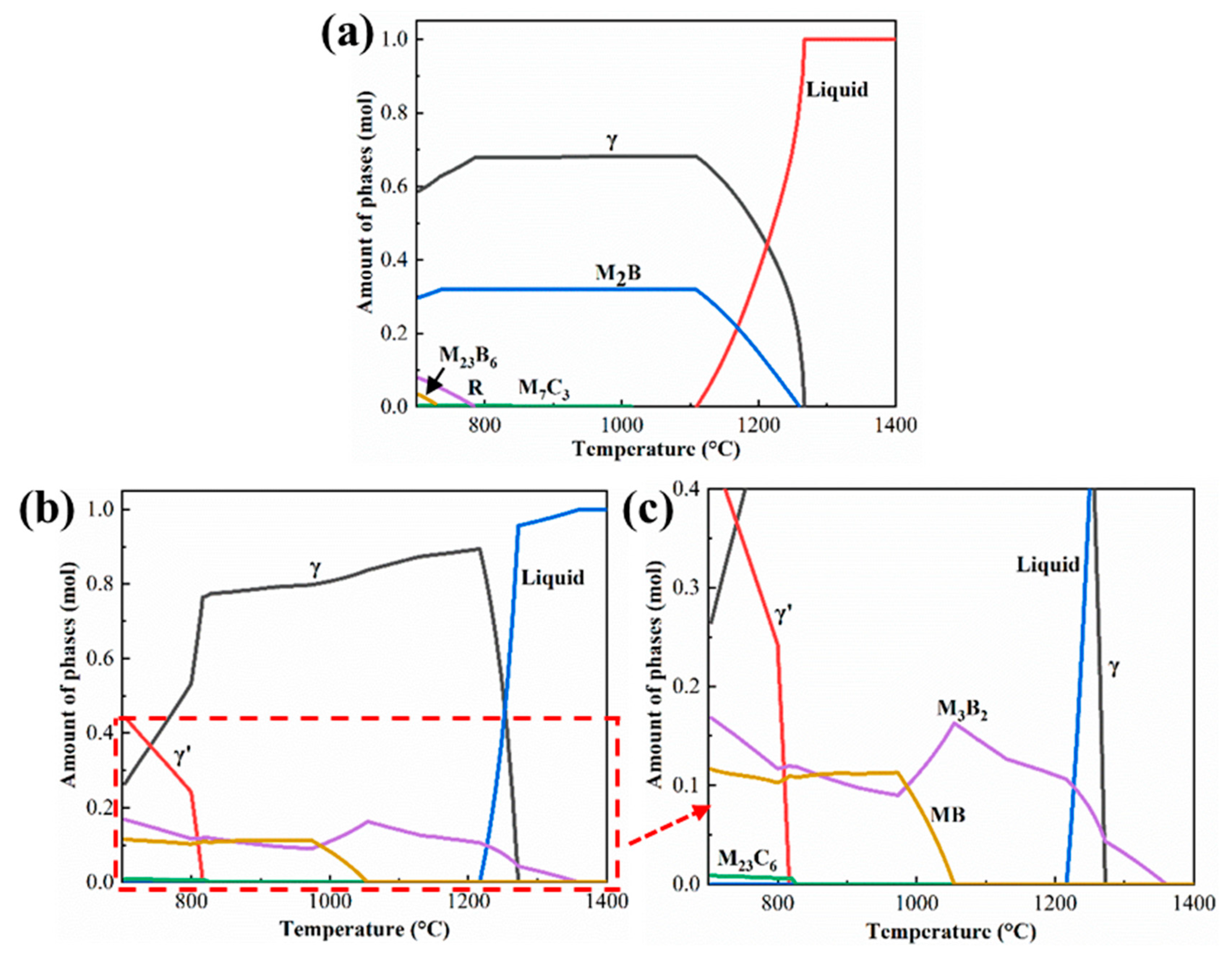

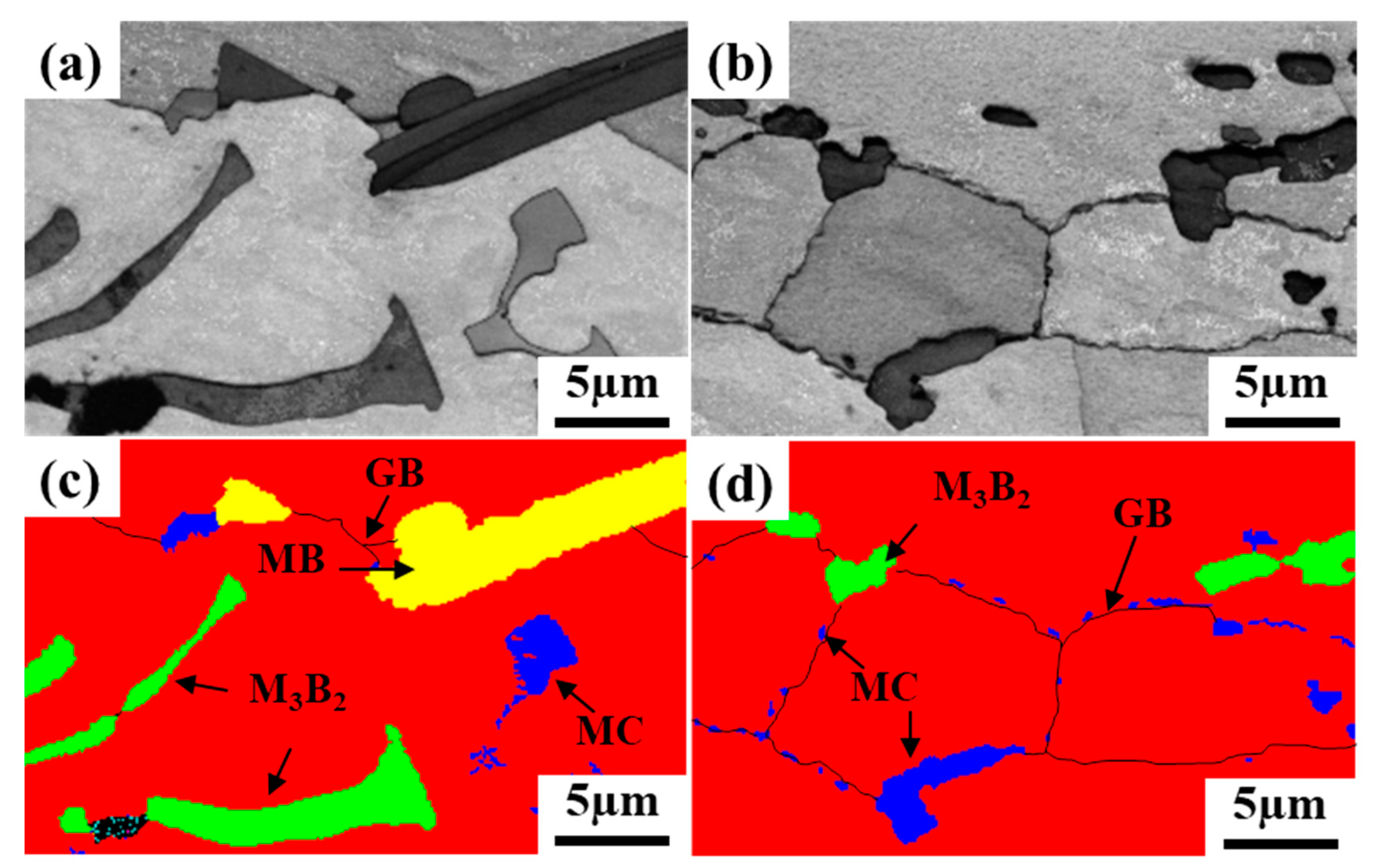
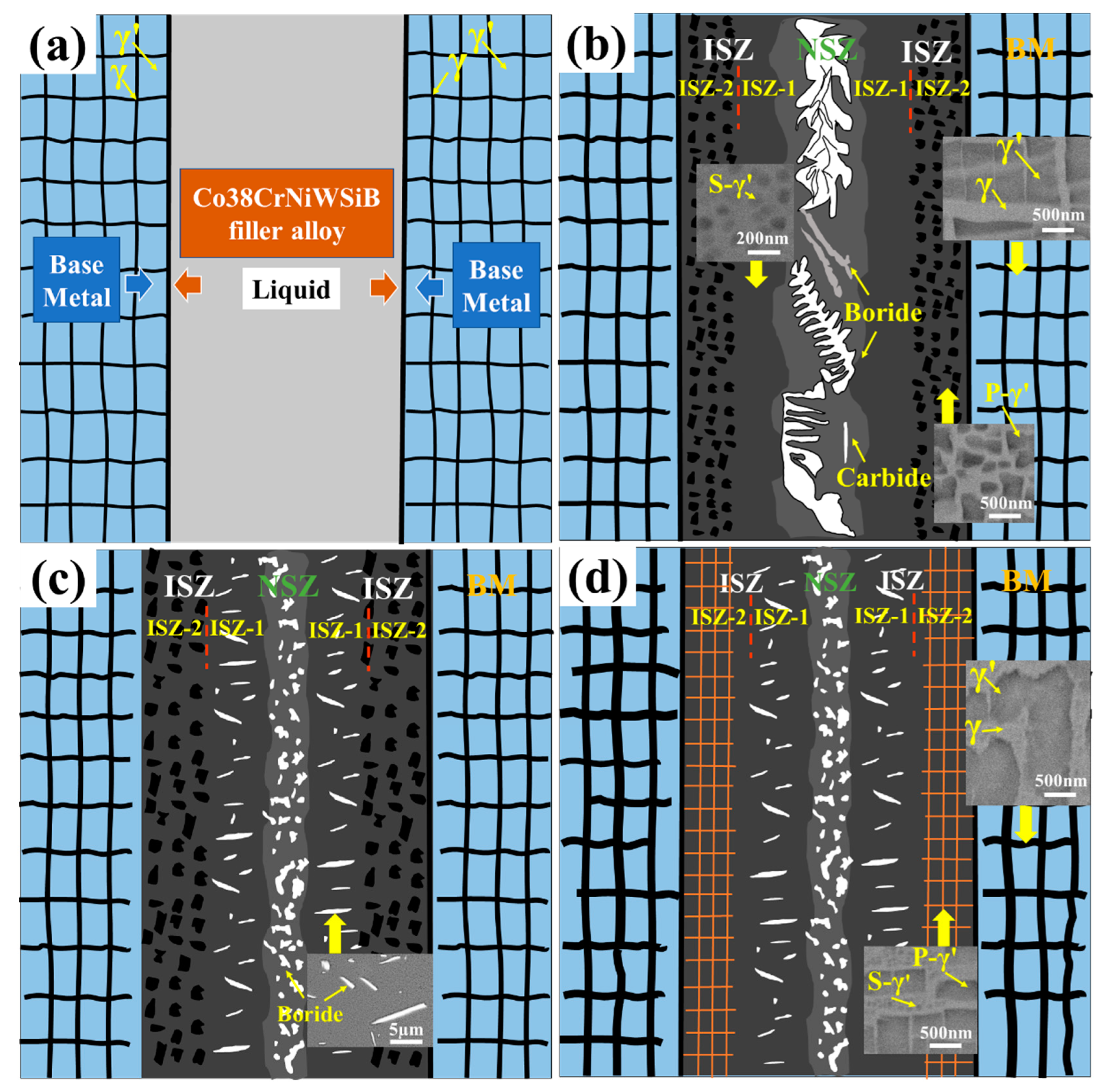


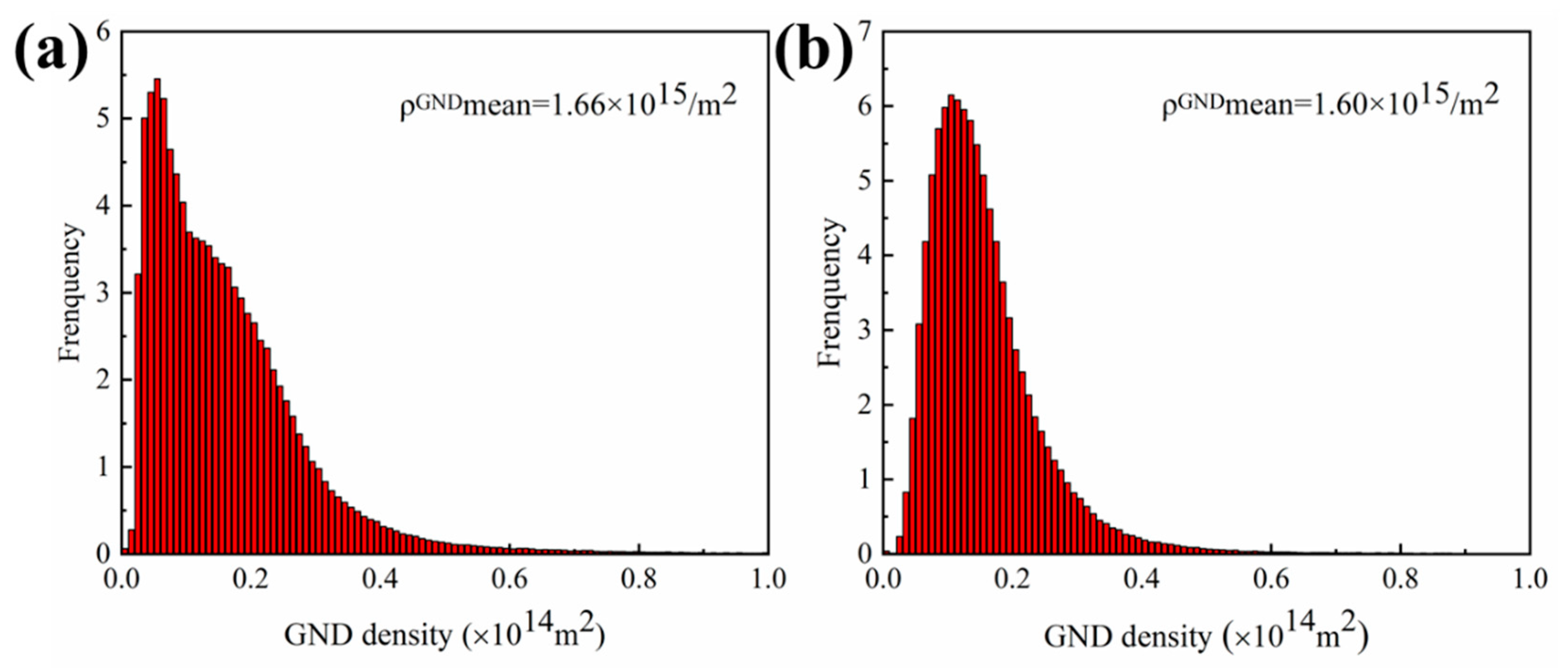


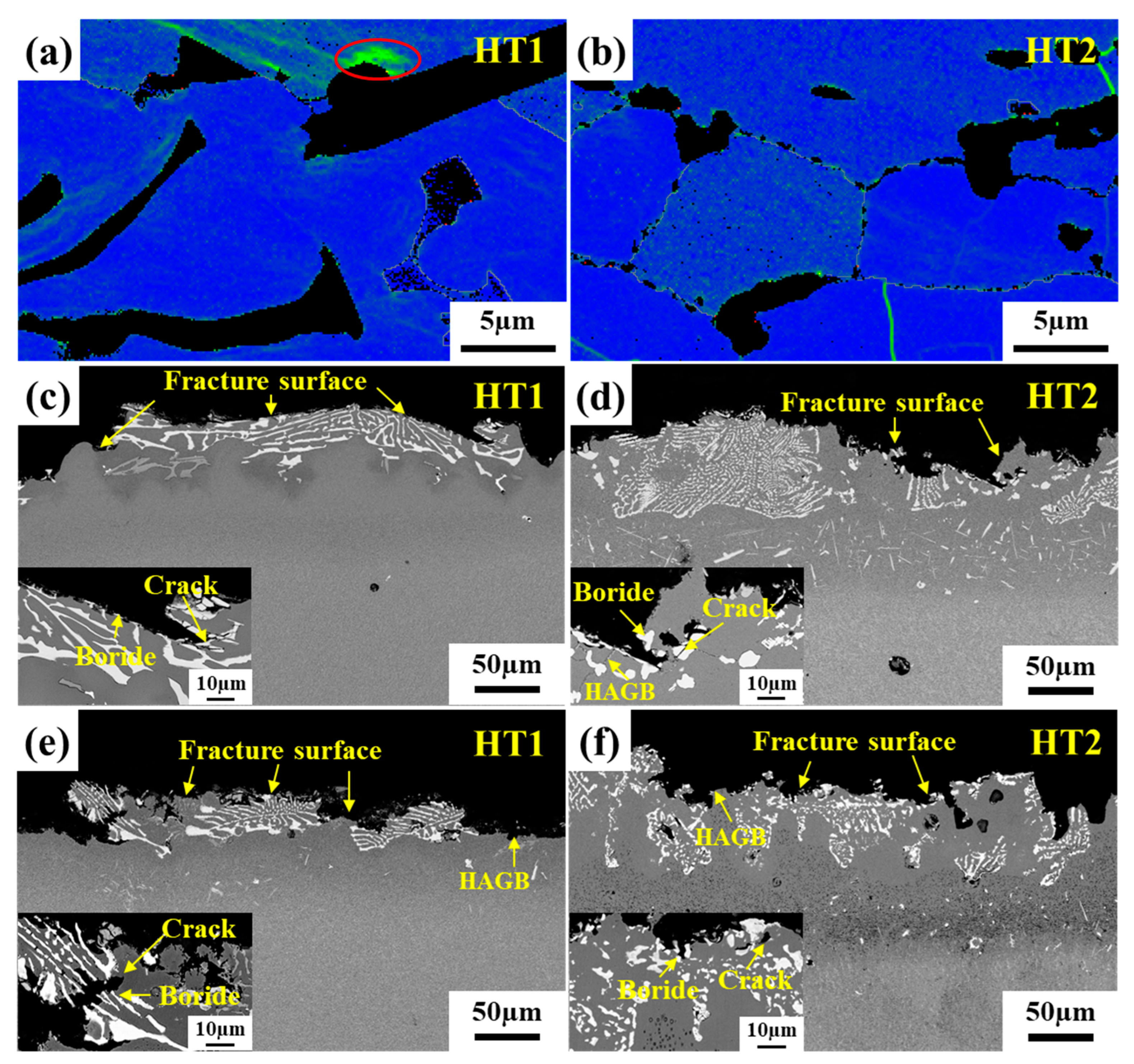
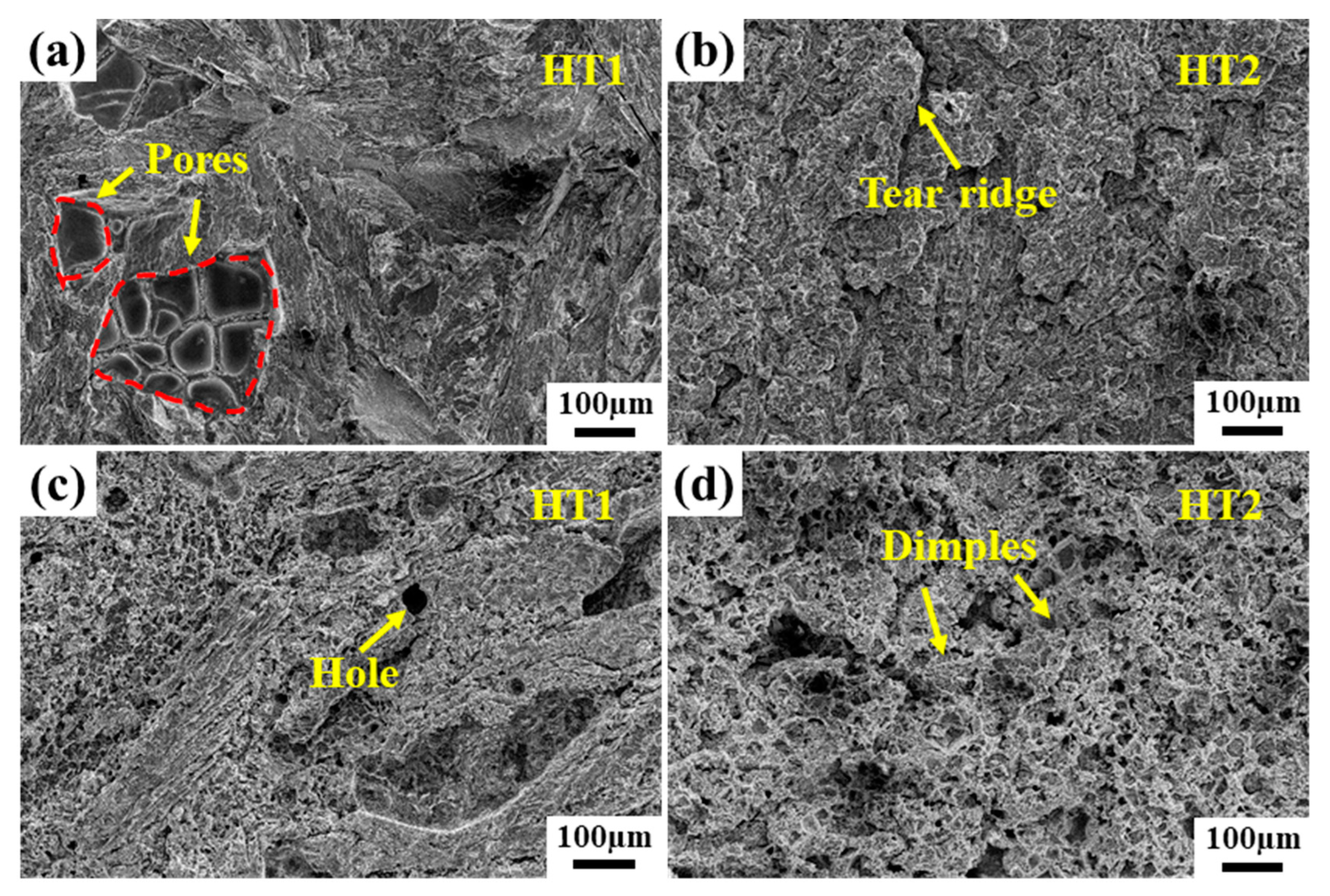
| Element | Co | Al | Cr + Mo + Ta + Hf | W | Re | Ru | Ni |
|---|---|---|---|---|---|---|---|
| Content | 10~14 | 4~6 | 9.5~16.6 | 5~7 | 4~7 | 3~5 | Bal. |
| Element | Co | Cr | Fe + La + Mn + W | B | Si | C | Ni |
|---|---|---|---|---|---|---|---|
| Content | 38 | 21.8 | 14.58 | 2.04 | 1.98 | 0.02 | 21.6 |
| Position | Co | Ni | Cr | C | Ta | Re | Ru | W | Hf |
|---|---|---|---|---|---|---|---|---|---|
| 1 | 1.65 | 1.96 | 3.52 | 66.70 | 23.23 | - | - | 0.97 | 1.97 |
| 2 | 11.55 | 3.03 | 70.92 | - | - | 6.34 | 4.83 | 2.87 | - |
| 3 | 30.91 | 19.11 | 14.76 | - | 11.75 | - | - | 23.48 | - |
| Elements | Cr | Ru | Re | Ta | Al | Co | W | Ni | |
|---|---|---|---|---|---|---|---|---|---|
| HT1 | ISZ-1 | 13.8 | 0.73 | 0.88 | 1.22 | 8.2 | 27.5 | 3.6 | Bal. |
| ISZ-2 | 7.33 | 1.45 | 2.25 | 2.94 | 11.14 | 15.48 | 2.62 | Bal. | |
| HT2 | ISZ-1 | 13.38 | 1.0 | 1.22 | 1.32 | 6.82 | 26.16 | 4.2 | Bal. |
| ISZ-2 | 7.49 | 1.67 | 2.08 | 2.70 | 12.18 | 16.41 | 3.17 | Bal. | |
Disclaimer/Publisher’s Note: The statements, opinions and data contained in all publications are solely those of the individual author(s) and contributor(s) and not of MDPI and/or the editor(s). MDPI and/or the editor(s) disclaim responsibility for any injury to people or property resulting from any ideas, methods, instructions or products referred to in the content. |
© 2023 by the authors. Licensee MDPI, Basel, Switzerland. This article is an open access article distributed under the terms and conditions of the Creative Commons Attribution (CC BY) license (https://creativecommons.org/licenses/by/4.0/).
Share and Cite
Zhang, Z.; Liu, J.; Zhu, C.; Huang, Y.; Wang, X.; Zhou, Y.; Wang, J.; Li, J. Effects of Post-Weld Heat Treatment on Microstructure and Mechanical Properties of the Brazed Joint of a Novel Fourth-Generation Nickel-Based Single Crystal Superalloy. Materials 2023, 16, 3008. https://doi.org/10.3390/ma16083008
Zhang Z, Liu J, Zhu C, Huang Y, Wang X, Zhou Y, Wang J, Li J. Effects of Post-Weld Heat Treatment on Microstructure and Mechanical Properties of the Brazed Joint of a Novel Fourth-Generation Nickel-Based Single Crystal Superalloy. Materials. 2023; 16(8):3008. https://doi.org/10.3390/ma16083008
Chicago/Turabian StyleZhang, Zhipeng, Jide Liu, Chongwei Zhu, Yuyu Huang, Xinguang Wang, Yizhou Zhou, Jianjun Wang, and Jinguo Li. 2023. "Effects of Post-Weld Heat Treatment on Microstructure and Mechanical Properties of the Brazed Joint of a Novel Fourth-Generation Nickel-Based Single Crystal Superalloy" Materials 16, no. 8: 3008. https://doi.org/10.3390/ma16083008









